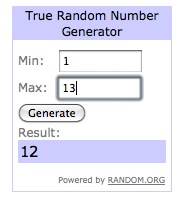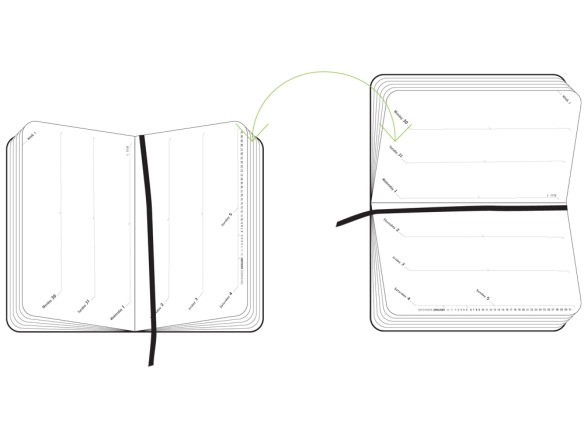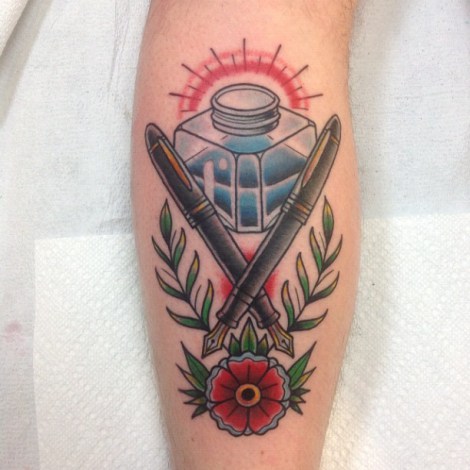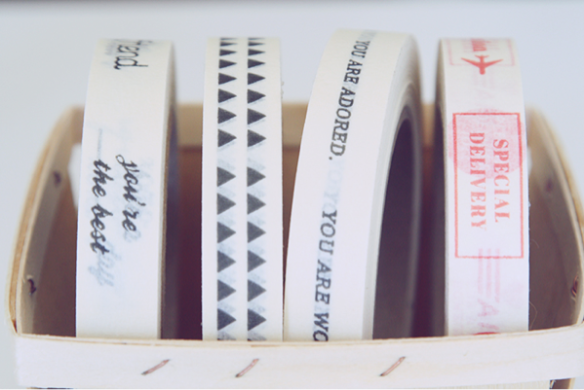
Congrats to Lamont for winning the OfficeMax Mechanical Pencils Giveaway. I will pass your email along to OfficeMax to get you shipping address. Thanks to everyone who left comments!


Congrats to Lamont for winning the OfficeMax Mechanical Pencils Giveaway. I will pass your email along to OfficeMax to get you shipping address. Thanks to everyone who left comments!

It was recently suggested that I try out the Miro brand of notebooks and I was happy to oblige. I purchased three different versions of their notebooks: a small lined journal (3.25×5.5″), a plain large journal (5×8″) and a set of utility notebooks (3.25×5.5″).
The Miro Journal Series notebooks are definitely going to get comparisons to Moleskines. They are hardcover and have black elastics running vertically, leatherette covers. They have ribbon bookmarks and even have a pocket in the back though its more of a slit than the gusseted pocket found in a Moleskine and other look-alikes.
The most notable difference in the appearance of the Miro notebooks is the colored edges. The Journal Series notebooks are available with either white or black leatherette covers with colored edges. They offer black, cyan, magenta, green or red edging with either cover option.On the covers and spines is a blind embossed logo which is subtle and tasteful.
I purchased the two most familiar sizes– small lined journal (3.25×5.5″), a plain large journal (5×8″)– but they also sell a larger 7×10″ size as well. The medium and large sizes are available in plain or lined versions but the small size is only available in lined. No grid or dot grid options for the Journal Series at present. Each book has 144 pages in it. The Journal Series sells for $9.99, $13.99 and $17.99 respectively.
The utility notebook is hopping on the Field Notes trend. Miro offers the traditional pocket sized (3.25×5.5″) Utility notebook but also a medium (5×8″) and large size (7×10″) which is more likely to be compared to the Moleskine Cahiers. All three sizes of Utility notebooks are available in blank, lined, gird or dot grid paper. They have the simple cardstock covers with either black, white, pink or green covers. Sets of two 68 page notebooks are $3.99, $5.99 and $7.99 respectively.
The lines on the Utility and Journal series notebooks look similar but when I double checked, the line spacing on the Utlitity notebook was 7mm and the Journal Series is 6mm in the same sized books. I don’t find this to be a big deal since the Utility notebooks are more likely to be used on-the-go so a bit more breathing room for the spacing is probably helpful where the Journal Series notebooks are likely to be used for longer form writing, meeting notes and such.
I also want to mention the difference in the papers. Both books feature a warm ivory color comparable to the Piccadilly I use at present. The lines on the paper are very fine but a medium/dark grey. The Journal Series paper is heavier weight (100gsm) than the Utility Series (no weight listed on the packagin). I wasn’t sure how the Utility notebooks would perform with inks.
The stitching on the Utility notebooks is exposed sewn stitching. It looks like a strong stitch and clearly visible. I like the stitching and is different to the staple-stitching on Field Notes. Again, its more consistent with the Moleskine cahiers.
I wanted to show the slit pocket on the back cover of the Journals. There is no gusseting so it won’t keep much, just a few scraps.
In writing samples, I was blown away with the paper quality for the price. I ended up testing a Sharpie at the end just to see if it could stand up to the challenge. None of my pens bled or feathered or splined at all. Even with the lighter weight paper of the Utility Notebooks, the paper still performed very well, especially for the price.
(The smudge on the Pilot Juice writing sample on the the Journal notebooks was a result of an exploding pen on my desk and not dry time on the paper, FYI)
There is a little show through on the reverse but I would definitely use both sides of the paper with almost all of my daily writing tools.
There are eight sheets in the back of the Journal series and four pages in the back of the Utility Series that are perforated so they can be easily removed.
Overall, I think these notebooks are a great value. I have not had time to fully abuse a Miro notebook to see how they hold up to long term use but I feel confident that they will be comparable to the Piccadilly or a Moleskine with great paper and intriguing colored edging. The Utility series is a great alternative to the Field Notes at almost half the cost. Miro also makes some wirebound notebooks with wood or felt covers which are visually more unique.
As the back-to-school season starts its roll forward, all the major manufacturers are releasing their 18-month planners as well as getting a head start on 2014.
Moleskine has released its newest planner format called the Turntable can be used in a vertical or horizontal format. Its available in a hardcover pocket-sized (3.5×5.5″) or large-size (5×8.25″) in several colors from great sellers like Jenni Bick (no, she is not paying me to say that but trust me, its a great shop) for $14.34 or $17.96 respectively.

Paperblanks are also offering their planners in 18-month formats or, if you are preparing for 2014, you can choose your 12-month edition now. They have lots of sizes and configurations available and the paper stock is better than Moelskine though not up to Rhodia standards.I have been using the Verso Format Black Moroccan Ultra size for 2013 and will probably purchase another Paperblanks for 2014. Some of the new textures and cover designs are gorgeous.
(For more about my current planner, visit my review of the Paperblanks 2013 planner. I also plan to provide a post-review of my planner after six months of use in the next few weeks.)
I am sure there will be more planners, agendas and calendars in the next few months to share. Do you still keep a paper planner? Do you have a favorite brand?
I’m delighted to congratulate the Pencil Revolution and its founder Johnny Revolution (as I was first introduced to him as) for being one of the first pen/paper/pencil bloggers and one of the longest running blogs on the occasion of its 8th anniversary.
John and his fellow comrades have reviewed pencils, erasers, sharpeners and more with an attention to detail that even a fountain pen lover would find impressive.
To dip your proverbial finger into the world of graphite love, check out the From the Archives series:
Viva la Revolution!
Pencils:
Pens:

Ink:
Paper and Notebooks:

Misc:
Conversations got started yesterday about folks’ preference for rubber stamp inks and I realized that this is a topic I’ve never pursued.
Since I like to use rubber stamps to annotate my paper planner and my mail, navigating the array of rubber stamp ink pads is something I thought I should investigate.
There are many different kinds of inks used on stamp pads: dyed-based, pigment-based and gel ink.
Dye based inks are what are most commonly found in office supply stores and self-inking stampers. The inks dry fast and is waterproof but depending on the stamp design and the type of material you are stamping, the liquidity of the ink can spread, obscuring your design. I tested a standard Office Depot brand felt pad with dye ink and found it a little runny. Both Clearsnap and Tsukineko offer versions of archival dye-based inks. Tsukineko’s is called Memento and Memento Dew Drops. Clearsnap sells Colorbox Archival Dye Ink pads in large pads and Cat’s Eyes. I have not tried either of these brands but they offer a wider array of color than your average office supply store, probably higher quality inks and the option for small, portable stamp pads.
Pigment-based inks are what are commonly found in the craft and scrapbook sections. There are standard pigment-based ink pads, as well as slower-drying and “chalk” styles. The slower drying inks are specifically designed to be used by crafters who use heat embossing powders with the inks and not something that is needed for everyday stamping like a return address stamp. Chalk inks dry to a matte finish comparable to the look of powder chalk or pastel but its just a descriptive term. They are not made from chalk. Both standard pigment-based and chalk-style inks dry fairly quickly and can be heat set (using something like an embossing heat gun or similar tool) I tested the ClearSnap Colorbox Cat’s Eye Pigment Pads, Tsukineko VersaColor Pigment Cubes, and Tsukineko Dew Drop Brilliance. All three of these products are also available in larger 2×3″ pads but I really like the small sized pads for portability.The best thing about the pigment inks is the huge array of color options including metallics and even a decent opaque white.
In preparing this review, I had trouble finding the Colorbox Cat’s Eye pads in singles. They are now available mostly as stacking sets of six pre-selected color packs sets called Queues. I really like the quality of the ink in the Colorbox pigment inks, next to my Uni Cinnabar Chop stamp pad that I picked up in Hong Kong, they are my favorites for retaining the design details of my stamps while laying down an even ink coverage. Since the Colorbox Cat’s Eyes are becoming more difficult to find in singles, I think I’ll probably be seeking out the VersaColor pigment cubes instead. The Dew Drop Brilliance pads are just sopping with ink and it is quite slow drying. The Dew Drop is definitely designed for crafters, not mail art.
Gel ink was a new discovery when I went to Office Depot yesterday on the recommendation to try some “standard” ink pads. I found red, blue and black pads in felt pad dye-based and the gel ink pad. The description on the package stated that it would maintain crisp lines and never need re-inking. In use, the ink was less vibrant than the others and seemed to sort of pool around the edges. I don’t really recommend it for creative uses. To be honest, I’d give this whole concept a pass.
All of the small pads have low sides that allow you to tap your stamp, regardless of size, across the pad so a small pad doesn’t mean you can only ink up small stamps. All the ink pads I tested range in price from about $1.50-$2.50 for a small Cat’s Eye, Dew Drop or Cube to $5-6 for the larger pads regardless of whether they are from an office supply store or an art/craft store. They are relatively small investments so you may want to grab one or two of the smaller ink pads with different ink types and try them out for yourself.
And one last tip, you don’t necessarily need to press hard when stamping to get even and complete coverage. Make sure the stamp is completely covered with ink and then lightly but evenly apply it to your paper, envelope or other ephemera. Having scrap paper nearby to test on is also helpful.
(photos can be viewed in more detail on my Stamp Pad Face-Off Flickr Set)